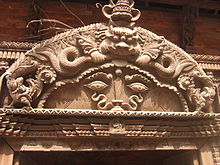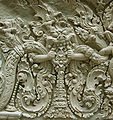Kirtimukha


Kirtimukha (Sanskrit kīrtimukha, mistakenly[1] also kīrttimukha, a bahuvrihi compound translating to "glorious face") is the name of a swallowing fierce monster face with huge fangs, and gaping mouth, quite common in the iconography of Indian and Southeast Asian temple architecture.[2] In Southeast Asia it is often referred to as Kala and in China it is known as T'ao t'ieh (Monster of Greed).
Origin and characteristics
The word mukha in Sanskrit refers to the face while kīrti means "fame, glory". Kirtimukha has its origin in a legend from the Skanda Purana when Jalandhara, an all-devouring monster created from Shiva, third eye willingly ate his body starting by its tail as per Lord Shiva's order, who pleased with the result gave it the name face of glory. Some authors have compared the Kirtimukha myth with the Greek myth of Ouroboros.[3]
The Kirtimukha is often used as a decorative motif surmounting the pinnacle of a temple or the image of a deity, especially in South Indian architecture. This face is sometimes assimilated to, or confused with, another sculptural element, the lion face (Simhamukha).[4] However, in order to be a Kirtimukha it has to be engaged in swallowing, for the Kirtimukha is the figure of the "all consuming"[5] This monstrous face with bulging eyes sits also as an embellishment over the lintel of the gate to the inner sanctum in many Hindu temples signifying the reabsorption that marks the entry into the temple.[6] Mostly it is only a face, although in some places its arms are portrayed as well.
Gallery
-
Kirtimukha at Amruteshvara temple in Annigeri, Dharwad district, Karnataka state, India
-
Kirtimukha at Kasi Visveshvara temple in Lakkundi, Gadag district, Karnataka state, India
-
Khmer Kirtimukha lintel at Vat Kralanh, Cambodia, Baphuon, Angkor style, 11th century
-
Kirthimukha at Siddhesvara temple in Haveri, Karnataka state, India
See also
Notes
- ^ Monier-Williams, s.v. kīrtti
- ^ "Yalli and Mukha". Retrieved 2007-02-25.
- ^ The Theosophical Society - The Predator, turning back on itself
- ^ Robert Beér, The encyclopedia of Tibetan symbols and motifs, ISBN 1-932476-10-5
- ^ Eckard Schleberger, Die indische Götterwelt
- ^ Rohan Bastin, The Domain of Constant Excess: Plural Worship at the Munnesvaram Temples in Sri Lanka








